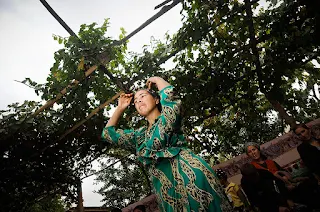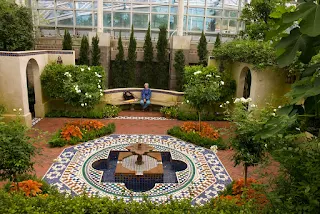Here with a Loaf of Bread beneath the Bough,In parts of the middle-East, a sunken garden is called "Paradise".
A Flask of Wine, a Book of Verse—and Thou
Beside me singing in the Wilderness—
And Wilderness is Paradise enow. -Quatrain XI of the Rubaiyat of Omar Khayyam
Placing the garden below the normal ground level and heaping the dirt that was excavated around the perimeter gets the plants out of the wind, prevents rain run-off, preserves moisture and humidity.
Some gardens even appear to "shingle" stone flags to funnel dew into the garden or to certain, cherished plants.
 |
| Grape arbor in Kyrgyzstan. Grapes and other vining plants are the fastest way to provide shade. Photo by Leonid Plotkin |
Variations on a theme include gardens that are surrounded by walls and gardens with fountains in the center of them. Often a grape arbor or a fruiting tree was trained to provide shade. Figs were a popular choice of fruit because they ripen over a very long period of time. Citrus were also popular.
The concept went through iterations as the Moors carried it to Sicily, Malta, Spain and Portugal.
From there it traveled to Mexico and then to what is now the American Southwest.
In some ways, these art-forms represent common forms of life in arid areas. Prickly and hard on the outside (brick walls) and sweet, abundant life on the inside. The people who dwelled in Hacienda were unapologetic: Trust is earned and earned slowly. The difference between inside-and-trusted and outside-and-untrusted was stark. Hostile environments create conservative systems.
At its best, it is an intelligent, passive, energy efficient system that sooths the mind, soul and body.
Blue
Blue was used with abandon inside haciendas. The blue of skies and lakes.
Some people have the belief that evil spirits cannot travel over water. While I consider that a superstition, it may have been a factor that contributed to the extensive use of blue tile.
Geometric shapes
A hold-over from the Islamic roots of the Hacienda are the abundance of tile mosaics and stark, rigid geometric shapes of shrubbery.
Conservative Islam prohibits "graven images" which are taken to mean paintings or sculpture of humans or animals. The concern is that people might be led astray and worship them as gods.
Evaporative cooling
Evaporative cooling can be a little bit tricky.
While it is entirely possible to lower the temperature of dry air by exposing it to a large amount of water-mist, that is not always the best solution.
While the temperature is lowered, the air is saturated with water and sweat is not whisked away nor does perspiration enhance "homeostasis". Homeostasis is our body's internal programming to keep our internal temperature constant.
Granny will founder in the cold, clammy air and Rotundo will be unable to cool himself. Furthermore, Rotundo will get various fungal infections because his garments will not dry out.
A far better solution is to have a semi-contained space with modulated air-infiltration and a source of open water or a fountain.
The semi-contained space, a courtyard if you prefer, shields the space from the blow-torch blast of un-tempered, desert winds. The "semi" means that the air infiltration is modulated throughout the day by doors or shutters or blinds to maintain a balance of "swamp cooling" and temperate humidity...say, roughly 60%.
Dry climates experience extreme day-night temperature swings and the interior walkways use thermal inertia to provide a temperate environment through much of the day. In the early morning, the west side of the courthouse is likely to be most comfortable as the morning sun warms the air. Then, through the course of the day and the seasons, the most "comfortable" area will move.
Slippery floors
An under-appreciated hazard of "swamp coolers" in humid climates is that sudden changes in temperature can cause hot, saturated air to cause condensation on cooler floors.
I worked in one award-winning "green" facility where the bathroom floors were as slick as ice several days in the spring every year. The condensate combined with the residual soap on the floors to make them dangerously slick.







Joe, don't know how to contact you any other way. I just mailed a pkg to you, due by Fri the 9th. It is addressed to Eaton Rapids Joe @ General Delivery, Eaton Rapids, Mich. You should just be able to go in and request it. -Rick
ReplyDeleteThank-you, sir.
DeleteI am on pins and needles.
More slippery floors.
ReplyDeleteWe live in the DFW area. Had an odd circumstance about two years ago. First noticed water on the tile floor around a toilet. Ruh-roh. Cleaned it up, and noticed the outside of the toilet tank was wet, as well a the underside of the tank lid. Hmm. Maybe the tank plumbing went south. Nope, working fine. Turned out to be just the right (or wrong) combination of inside air temp and humidity and water temp. After a flush, the tank filled with cold water, and condensation formed just like on a glass of ice water.